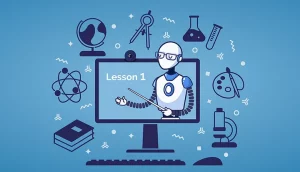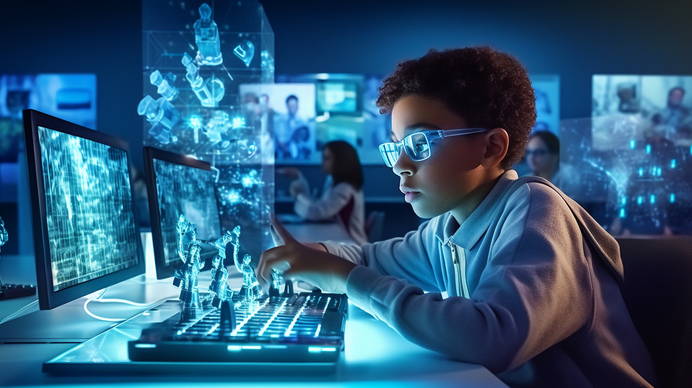Introduction:
The dusty image of the lone teacher at the chalkboard, dispensing knowledge to rows of passive students, is fading into the past. Artificial Intelligence Education stands at a crossroads, propelled by the demands of a rapidly changing world. We need students equipped with new skills and knowledge to navigate the complexities of the 21st century. Traditional methods, while valuable, often struggle to keep pace with this accelerating demand.
This is where Artificial Intelligence enters the scene, sparking both enthusiasm and skepticism. Can Artificial Intelligence be the magic wand that revolutionizes education, or is it merely a fleeting fad? This article explores the transformative potential of AI. And emphasizing its synergistic role with good teaching practices. We’ll delve into the benefits of Artificial Intelligence for educators and parents. And showcasing how it can personalize learning, streamline tasks, and ultimately prepare students for a future shaped by technology.
Understanding Artificial Intelligence

Before diving into practical applications, let’s shed the mystique surrounding Artificial Intelligence. Forget images of robots taking over classrooms. AI is a broad term encompassing technologies capable of learning and problem-solving, drawing insights from data to make informed decisions. Imagine AI-powered tools that adapt to individual learning styles, provide real-time feedback, and automatically grade assessments, freeing up valuable time for educators to focus on more personalized instruction.
Artificial Intelligence as a Partner, Not a Replacement
Effective teaching has always been about understanding individual needs and tailoring instruction accordingly. AI tools can enhance this core principle by analyzing student data (anonymously and ethically, of course) and identifying areas of strength and weakness. Imagine an Artificial Intelligence tool that flags students struggling with specific concepts, allowing teachers to intervene early and provide targeted support. This is not about robots replacing teachers; it’s about empowering them with insights and tools to personalize learning like never before.
Personalized Learning with Artificial Intelligence

Imagine a classroom where each student progresses at their own pace, challenged yet supported. Artificial Intelligence-powered platforms can create individualized learning paths, dynamically adjusting to each student’s strengths and weaknesses. This dynamic learning environment caters to diverse learning styles, encouraging deeper understanding and engagement. Rather than a monotonous lecture for all, students embark on personalized journeys, exploring concepts through interactive exercises, simulations, and multimedia resources curated by AI based on their unique needs.
Empowering Educators: AI as a Time-Saving Ally
Educators juggle countless tasks, leaving little time for individual attention. AI can alleviate some of this burden by handling repetitive tasks like grading multiple-choice questions and providing personalized feedback on written work through sophisticated language processing techniques. Imagine the time saved! This frees up valuable time for more personalized interactions and creative instruction, allowing educators to focus on their core competency: inspiring and guiding young minds.
Collaboration & Critical Thinking: The Human Touch Remains Vital
It’s crucial to remember that AI is a tool, not a magic solution. Critical thinking, collaboration, and creativity are essential skills that AI cannot replace. Educators remain central to fostering these competencies, guiding students to analyze information, solve problems, and communicate effectively. AI can facilitate these processes by providing access to diverse resources and facilitating collaborative projects, but the human element of mentorship, motivation, and critical thinking remains irreplaceable.
Navigating the Future: Ethical Considerations and Responsible Use

As with any powerful technology, responsible use is paramount. Issues of data privacy, algorithmic bias, and equity must be carefully considered. Educators and parents share the responsibility to ensure AI is used ethically, inclusively, and transparently. This requires open discussions, transparent implementation, and ongoing monitoring to ensure AI serves the best interests of all students.
Conclusion: A Brighter Learning Landscape
The future of education is not about robots replacing teachers, but rather about harnessing the power of AI to amplify good teaching practices and create a more personalized, engaging, and effective learning environment. By leveraging AI thoughtfully and responsibly, we can unlock the potential of every student and prepare them for success in a rapidly evolving world.




